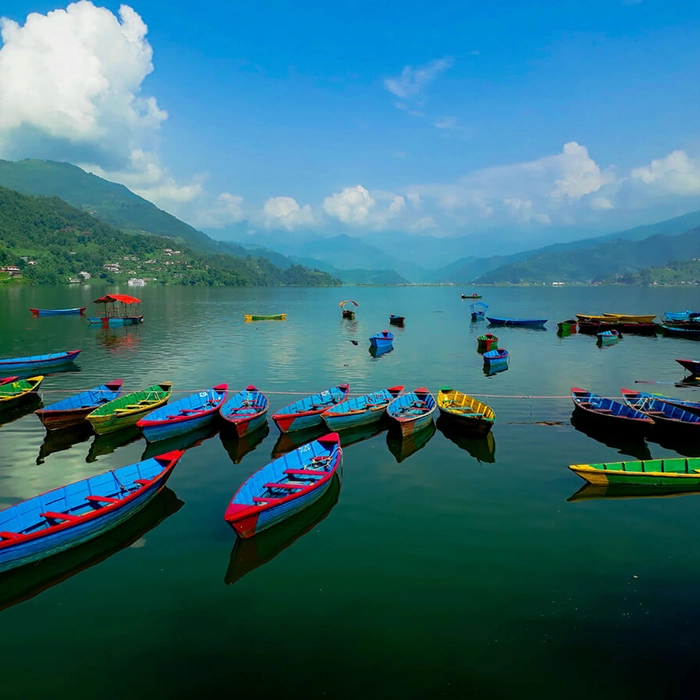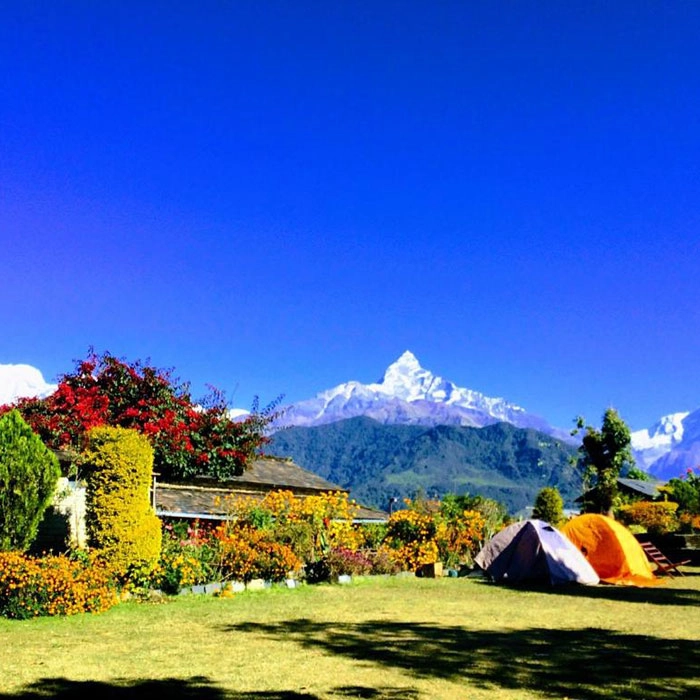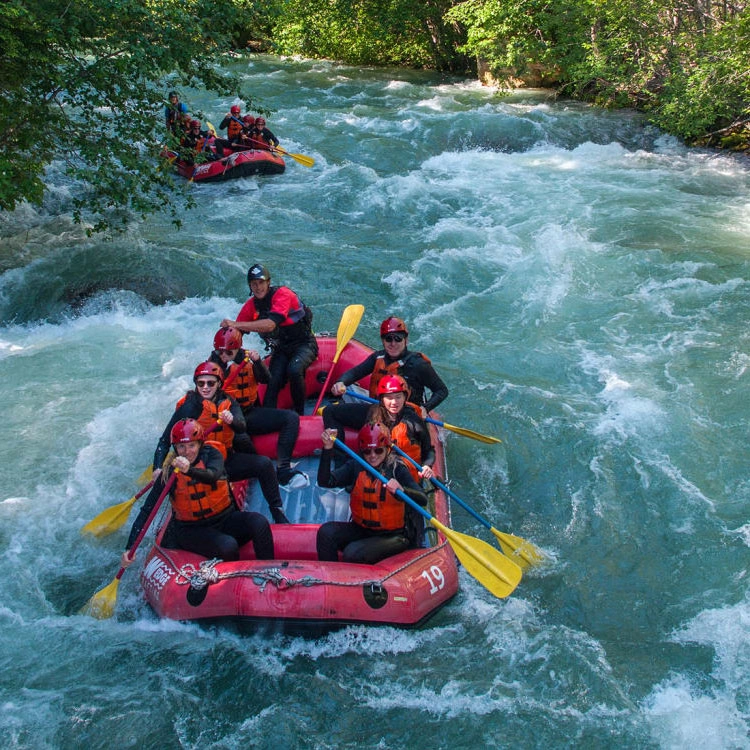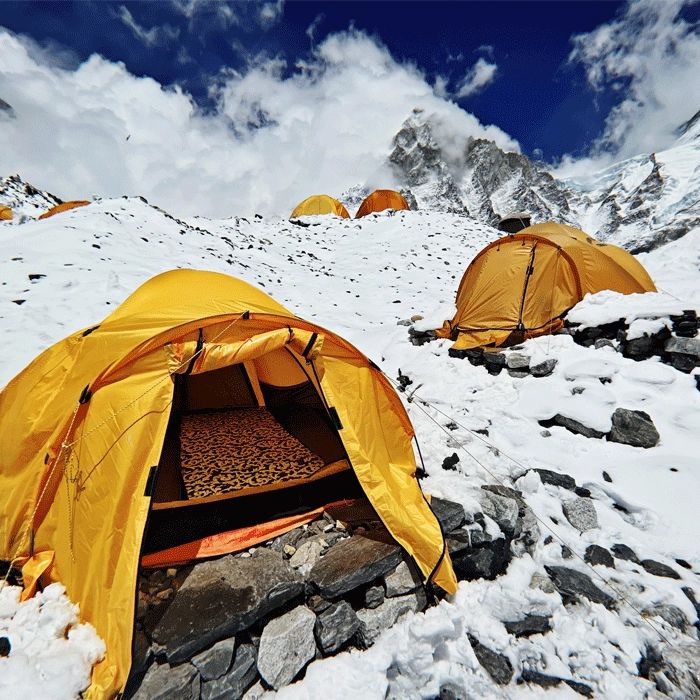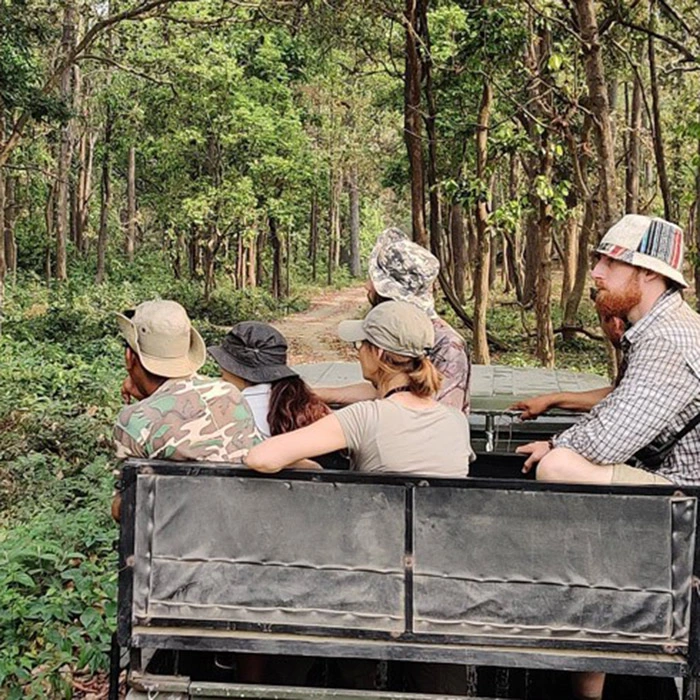LANGTANG VALLEY TREK
US$1,530.00
/pp
-
12 Days
-
Langtang
-
Spring/Autumn
-
Trekking
-
4,985 Meters
-
Moderate
-
Jeep / Bus
-
01-16 People
-
JH#242
 Overviews
Overviews
Embark on the Langtang Valley Trek, a journey through one of Nepal’s most stunning and accessible trekking regions. This Langtang Valley trek offers a perfect blend of natural beauty, cultural richness, and exhilarating adventure. Your Langtang Valley Trek adventure begins from Syabrubesi, where the trail leads you through lush forests, charming Tamang villages, and verdant landscapes. As you ascend, you’ll be treated to mesmerizing views of Langtang Lirung (7,227 meters) and the surrounding peaks. The highlight of Langtang Valley trek is Kyanjin Gompa, a serene and ancient monastery nestled in the heart of the valley. From here, you’ll explore two of the most renowned viewpoints in the region: Tsergo Ri and Kyangjin Ri. These vantage points offer panoramic views of the snow-capped Himalayas, glaciers, and the expansive Langtang Valley. The trek to these peaks is challenging yet rewarding, providing an unforgettable experience for both seasoned trekkers and nature enthusiasts. On your return journey, the trail winds back to Syabrubesi, offering a different perspective as you pass through Bamboo. The diverse landscapes and cultural encounters along the way make this trek a truly immersive experience. Spring and autumn are the best seasons for the Langtang Valley Trek, offering clear skies and pleasant temperatures. The region is known for its stunning rhododendron forests in the spring and vibrant hues in the autumn, enhancing the trek’s visual appeal. Despite the challenges posed by the 2015 earthquake, the resilient local communities have worked hard to restore the trails and infrastructure, ensuring a safe and rewarding trek. The Langtang Valley Trek is an ideal choice for those seeking a shorter yet equally captivating Himalayan adventure, with breathtaking landscapes, rich cultural experiences, and the thrill of high-altitude trekking. Langtang Valley Trek DifficultyThe Langtang Valley Trek is considered a moderate difficulty level trek, making it an excellent choice for beginners and experienced hikers alike. The trail involves daily walks of 5 to 7 hours through forested trails, scenic valleys, and traditional Tamang villages, gradually ascending to an altitude of around 3,870 meters (Kyanjin Gompa). While the trek does not reach extremely high altitudes and doesn’t require technical skills, a reasonable level of physical fitness is recommended to handle some steep climbs and uneven terrain. With proper pacing and acclimatization, the Langtang Valley Trek is both accessible and rewarding, offering a perfect blend of cultural experience and mountain scenery. Langtang Valley Trek CostThe Langtang Valley Trek delivers excellent value with a cost that typically covers essential services such as a licensed trekking guide, porter support, Langtang National Park and TIMS permits, tea-house accommodations, all meals during the trek, and ground transportation to and from the trailhead. Solo trekkers enjoy individualized attention and full support, while group trekkers benefit from progressive discounts, with the per-person rate decreasing as group size grows. We also feature special seasonal offers during off-peak months, allowing you to enjoy the Himalayan landscapes and cultural charm of the Tamang region at even better value. Although our website lists standard international rates, we encourage travelers working together as a private group (friends, families, or clubs) to contact us directly for a personalized quote. We’re dedicated to delivering the most competitive pricing alongside the highest standard of service, ensuring your Langtang adventure is both memorable and affordable.
 Itinerary (Plan)
Itinerary (Plan)
Arrive in Kathmandu (1,400 m / 4,593 feet), Nepal's vibrant capital, where you'll be warmly welcomed with marigold garlands. After transferring to your hotel, take time to relax and acclimate to the bustling city. Discover vibrant local markets, indulge in traditional Nepali dishes, and delve into Kathmandu's rich cultural tapestry. This initial day is perfect for easing into your journey, setting the stage for the exciting adventures ahead in Eastern Nepal. A representative from Jagadamba Holidays will ensure a smooth and pleasant arrival.
Optional Evening Activity:
If you wish, you can spend your evening experiencing the Pashupatinath Aarti, a captivating religious ceremony held at the Pashupatinath Temple. The Aarti usually begins around 6:00 PM and lasts for approximately an hour. This ceremony is a mesmerizing display of traditional music and rituals, providing a profound insight into Hindu spiritual practices. Please check the exact time for the Aarti on the day of your visit, as it may vary. This option is not included in the standard itinerary but offers a unique opportunity to immerse yourself in local culture.
Embark on a scenic drive from Kathmandu to Syabrubesi (1,503 m / 4,931 ft.), a vibrant village at the gateway of the Langtang region. The journey begins early, as you leave the bustling capital behind and head into the serene countryside. The journey from Kathmandu to Syabrubesi by jeep covers 122 kilometers and takes around 6-7 hours . The drive takes you through lush green hills, terraced farmlands, and picturesque villages, offering a glimpse into the rural lifestyle of Nepal. As the road winds alongside the Trishuli River, you'll be treated to stunning views of Ganesh Himal, Langtang Lirung, and other Himalayan peaks.
The journey also passes through charming towns like Trishuli Bazaar and Dhunche, where you can stop for refreshments and soak in the local culture. The final stretch involves navigating winding mountain roads, adding an element of adventure to the drive. Upon arrival in Syabrubesi, a bustling hub for trekkers, you can explore the village, interact with locals, and prepare for the trek ahead. The welcoming atmosphere of Syabrubesi (1,503 m / 4,931 ft.) sets the perfect tone for your upcoming adventure into the Langtang Valley.
Start your Great Langtang Trek with a hearty breakfast at your lodge in Syabrubesi before embarking on the scenic Syabrubesi to Sherpagaon trek. The trail begins with a steep uphill climb to the traditional Tamang village of Khangjim (2,280 m / 7,480 ft.), taking roughly three hours through dense forests, terraced fields, and picturesque landscapes. Along the way, enjoy mesmerizing views of the Langtang River, terraced farmland, and surrounding Himalayan peaks, making this an immersive Himalayan adventure.
Upon reaching Khangjim, you can rest and interact with locals, experiencing the vibrant culture and hospitality of the Tamang people. From Khangjim, the trek continues with a gentler ascent, winding through lush forests, crossing sparkling mountain streams, and offering uninterrupted views of the Langtang Valley and its dramatic peaks.
The journey covers approximately 10.1 kilometers, with an ascent of 1,300 meters and a descent of 190 meters, typically taking 5 to 6 hours. As you approach Sherpagaon (2,563 m / 8,409 ft.), perched on a scenic ridge, you are rewarded with panoramic vistas of the Nepal Himalayas, making it the perfect spot to relax and soak in the serene mountain atmosphere.
This trek is ideal for travelers seeking a blend of adventure, culture, and Himalayan scenery. From the charm of rural Tamang villages to breathtaking mountain panoramas, the Syabrubesi to Sherpagaon trek offers an unforgettable Langtang Valley trekking experience in Nepal.
After a hearty breakfast at your lodge in Sherpagaon, set out on the scenic Sherpagaon to Thangsyap trek, part of the renowned Great Langtang Trek in Nepal. This beautiful route passes through key villages like Lama Hotel (2,480 m / 8,136 ft.) and Ghodatabela (3,030 m / 9,941 ft.), offering travelers an authentic glimpse into the daily life of the Tamang communities of the Langtang Valley.
The trek spans approximately 11.6 kilometers, with an ascent of 810 meters and a descent of 200 meters, typically taking 5 to 6 hours. The trek winds through lush oak, pine, and rhododendron forests, offering chances to spot Himalayan wildlife including red pandas, langurs, and rare birds. Following the Langtang River, the trail crosses several suspension bridges and passes small settlements like Rimche and Bamboo, giving trekkers a chance to experience local culture while enjoying stunning natural surroundings.
As you ascend, the path opens to panoramic views of the Langtang Valley and snow-capped Himalayan peaks, providing perfect opportunities for photography and nature appreciation. Nearing Thangsyap (3,140 m / 10,433 ft.), you will find lush meadows, terraced fields, and a serene mountain village, ideal for an overnight stay.
This Thangsyap trekking route is perfect for travelers seeking a blend of adventure, culture, and Himalayan scenery. From Langtang Valley trekking and wildlife spotting to interacting with Tamang villages, this journey delivers a full Nepal trekking experience. The Sherpagaon to Thangsyap trek is a highlight of the Great Langtang Trek, promising breathtaking landscapes, cultural immersion, and unforgettable Himalayan adventures.
After a hearty breakfast at your lodge, begin your trek toward Kyanjin (3,830 m / 12,566 ft.), one of the key highlights of the Great Langtang Trek in Nepal. Today’s journey offers breathtaking views of towering Himalayan peaks and a poignant glimpse of the Langtang village, which was affected by past natural disasters, adding historical and emotional depth to your adventure.
The trail spans approximately 10.5 kilometers, typically taking 4 to 5 hours, with an ascent of 720 meters and a descent of 50 meters. Moderate ascents allow trekkers to fully enjoy the surrounding landscapes. The route winds through lush forests of pine, oak, and rhododendron, passes terraced fields, and follows meandering streams, offering an immersive experience in the heart of the Himalayas. Breathtaking views of Langtang Lirung (7,227 m / 23,711 ft.) and surrounding snow-capped peaks offer ideal spots for photography and soaking in the Himalayan scenery.
Along the way, trekking through traditional Tamang villages, you can observe stone-built houses, terraced farmlands, and local daily life, offering a rich cultural experience. Kyanjin is a peaceful mountain village nestled amid the dramatic Himalayan peaks, offering a serene retreat to relax and take in the stunning surroundings. The village is home to the Kyanjin Gumba, a historic Buddhist monastery, making it both culturally and scenically significant.
Reaching Kyanjin represents the first major destination of the Great Langtang Trek, offering travelers a sense of accomplishment and a chance to acclimatize while enjoying the beauty of the Himalayas. This stage combines adventure, culture, and natural splendor, making an overnight stay in Kyanjin both relaxing and inspiring. From panoramic mountain views to immersive cultural encounters, Kyanjin sets the tone for the unforgettable journey ahead, including the trek toward Gosainkunda, the next major highlight.
Begin your Tserko Ri Trek early to experience breathtaking Himalayan panoramas and maximize your adventure. Starting from Kyangjin Gompa (3,870 m / 12,697 ft.), this trek offers one of the most rewarding high-altitude experiences in Nepal. With no tea houses along the trail, make sure to carry breakfast, lunch, and plenty of water. Alternatively, you can enjoy a relaxed day in the serene village of Kyangjin Gompa, surrounded by stunning Himalayan peaks—a perfect opportunity for acclimatization, rest, and photography. For adventure seekers, the challenging and scenic Tserko Ri hike is highly recommended.
The trek follows a steep trail for approximately 5–6 hours one way, winding through vibrant alpine meadows and yak pastures. Along the way, enjoy spectacular views of Langtang Lirung (7,227 m / 23,711 ft.), Langshisa Ri (6,427 m / 21,086 ft.), and neighboring snow-capped peaks. As you ascend, the trail becomes steeper and the air thinner, intensifying the challenge and making the summit an exceptionally rewarding accomplishment.
At the summit of Tserko Ri (4,985 m / 16,355 ft.), trekkers are rewarded with panoramic vistas of the Langtang Valley, glaciers, and the Himalayan range stretching toward Tibet. This nearly 5,000-meter vantage point is perfect for photography and offers an unforgettable high-altitude adventure. The descent back to Kyangjin Gompa typically takes 2–3 hours.
For those seeking a more relaxed day, Kyangjin Gompa provides the chance to explore the village, visit the local cheese factory, or simply soak in the tranquil Himalayan surroundings. Whether hiking to Tserko Ri or enjoying the village, this itinerary blends adventure trekking, cultural immersion, and nature exploration.
The round-trip distance to Tserko Ri is 9.6 kilometers, with a total duration of 7–9 hours, including an ascent and descent of 1,090 meters—offering a perfectly balanced and rewarding Himalayan trekking experience in Nepal’s Langtang Valley.
Begin your day with an unforgettable sunrise hike to Kyangjin Ri (4,779 m / 15,679 ft.), one of the most celebrated viewpoints in the Langtang Valley, offering unparalleled Himalayan panoramas. This short yet rewarding trek covers approximately 2.48 kilometers round trip and typically takes 2–3 hours to complete, with an ascent and descent of 380 meters.
As you ascend through the crisp morning air, anticipation intensifies for the sweeping Himalayan vistas that await at the summit. When the first rays of sunlight illuminate the snow-clad peaks, the Langtang Himal range comes alive in shades of gold and crimson—a perfect moment for photography and quiet reflection. From the summit, you can admire sweeping vistas of Langtang Lirung, surrounding glaciers, and the serene valley below. After savoring the scene, descend back to Kyangjin Gompa for a hearty breakfast.
Following this breathtaking start, continue your journey by trekking from Kyangjin Gompa to Lama Hotel (2,480 m / 8,136 ft.). The route retraces your steps along the Langtang Valley trail, spanning 18.4 kilometers over 6–7 hours. On this section, you will ascend approximately 50 meters and descend around 1,420 meters, making it a predominantly downhill journey that’s easier on the lungs but still engaging for the legs.
This return trek offers a fresh perspective on the landscapes you passed earlier—lush rhododendron and oak forests, charming Tamang settlements, and the glistening Langtang River running alongside the path. The trek offers opportunities to encounter Himalayan wildlife, including langurs, elusive red pandas, and a variety of colorful bird species.
As the gentle rustling of leaves and the sound of the flowing river accompany your descent, you’ll feel a sense of calm and connection to nature. Upon reaching Lama Hotel, you’ll be welcomed into a warm, rustic atmosphere, perfect for relaxing and reflecting on a day that seamlessly blended high-altitude adventure with natural serenity.
The trek from Lama Hotel to Syabrubesi (1,503 m / 4,931 ft.) is one of the most stunning and rewarding sections of the Langtang Valley Trek, offering a perfect mix of adventure, culture, and serene Himalayan landscapes. Starting at Lama Hotel (2,480 m), trekkers are immediately surrounded by the peaceful valley scenery, walking through charming Tamang villages, vibrant terraced fields, and dense bamboo and oak forests. The trail follows the crystal-clear Langtang River at points, providing soothing riverside views and opportunities to spot native Himalayan wildlife. Towering snow-capped peaks of the Langtang Himal range dominate the horizon, creating unforgettable photo opportunities and a sense of awe-inspiring natural beauty. This segment is ideal for travelers who want to combine cultural immersion, nature exploration, and refreshing trekking in one memorable Himalayan journey.
After breakfast at Lama Hotel, the trek continues to Syabrubesi (1,503 m), covering approximately 11.4 kilometers. The trail includes a gentle 50-meter ascent near Bamboo Village and a 1,080-meter descent, making it mostly downhill but invigorating for trekkers. The journey typically takes 5–6 hours, allowing plenty of time to pause for photographs, enjoy short rests, and absorb the valley’s serene atmosphere.
Along the route, trekkers pass through lush bamboo groves, dense forests, and terraced fields that reflect the rich farming traditions and daily life of local communities. The melodic sounds of flowing water from the Langtang River, birdsong, and rustling leaves create a peaceful ambiance that enhances the trekking experience. This section is perfect for travelers who want a balance of activity and relaxation while experiencing authentic Himalayan nature and culture.
As the trail opens into broader landscapes, panoramic views of the Langtang Himal unfold. Snow-capped peaks, cascading rivers, and traditional villages blend seamlessly, offering a harmonious combination of adventure trekking and cultural exploration. By the time trekkers reach Syabrubesi, they are rejuvenated by the valley’s natural beauty, immersed in vibrant Tamang culture, and inspired by the majestic Himalayan scenery. This segment leaves a lasting impression of Nepal’s serene landscapes and cultural richness, making it one of the most memorable parts of the Langtang Valley Trek.
After completing the breathtaking Langtang Valley Trek, embark on a scenic drive from Syabrubesi to Kathmandu (1,400 m / 4,593 feet), a journey that combines rural charm, Himalayan vistas, and cultural immersion. The distance from Syabrubesi to Kathmandu is approximately 122 kilometers, typically taking around 6-7 hours by jeep or private vehicle. Departing early in the morning, trekkers leave behind the tranquil villages and serene forests of the Langtang region to return to the vibrant capital city of Nepal.
The route follows the Trishuli River, offering some of the most picturesque landscapes of rural Nepal. Along the way, travelers can admire lush green hills, terraced farmlands, and traditional villages that showcase the local lifestyle. Towering Himalayan peaks, including Ganesh Himal and Langtang Lirung, punctuate the horizon, creating incredible photo opportunities and moments of reflection on the trek.
This drive also serves as a perfect finale to your Langtang adventure, allowing you to relax while still soaking in the beauty of Nepal’s countryside. Whether you travel in a comfortable deluxe bus or a private jeep, the ride offers a smooth and enjoyable experience, with plenty of chances to pause, capture scenic vistas, or simply appreciate the natural splendor that has defined your trekking journey.
As you approach Kathmandu (1,400 m), the city’s bustling streets, vibrant culture, and historic architecture slowly emerge, marking the end of your Himalayan expedition. Upon arrival, you can unwind at your hotel and enjoy a celebratory evening in Thamel, the heart of Kathmandu’s tourist district, with its lively markets, restaurants, and cultural attractions. This final leg of the journey provides a seamless transition from tranquil mountains to urban excitement, completing your unforgettable Langtang Valley Trek experience.
Embark on a cultural and historical tour of Kathmandu Valley, beginning at 9 AM with a visit to Patan Durbar Square, one of the most iconic heritage sites in Nepal. Patan Durbar Square, nestled in the heart of Lalitpur, offers a captivating display of Newari architecture, featuring intricately carved temples, elegant courtyards, and ornate wooden palaces. Highlights include the Hiranya Varna Mahavihar, a stunning golden temple, and the Mahabouddha Temple, inspired by the Mahabodhi Temple of Bodh Gaya. The centerpiece, Patan Palace, now houses the Patan Museum, offering visitors an immersive experience in Nepalese art, history, and culture. Walking through Patan Durbar Square provides travelers a vivid insight into the spiritual and artistic heritage of the Newar people.
Next, continue your cultural and historical tour of Kathmandu Valley at Bhaktapur Durbar Square, a UNESCO World Heritage Site renowned for its medieval charm. The square is adorned with majestic temples, intricately carved palaces, and historic monuments, reflecting centuries of architectural mastery. The 55-Window Palace is a standout, along with Vatsala Temple and Siddhi Lakshmi Temple, both celebrated for their elaborate sculptures and carvings. The iconic Nyatapola Temple, a five-story pagoda dedicated to the goddess of prosperity, dominates the square. Bhaktapur Durbar Square immerses visitors in the living traditions, handicrafts, and cultural vibrancy of Nepal’s Newar civilization.
Finally, conclude your cultural and historical tour of Kathmandu Valley with a visit to Changu Narayan Temple, perched on a scenic hill overlooking the Kathmandu Valley. This ancient temple, dedicated to Lord Vishnu, is considered one of Nepal’s oldest and most revered Hindu sites, dating back to the 4th century. The temple complex is adorned with intricate carvings, vibrant sculptures, and historic inscriptions, reflecting the artistry and spiritual devotion of the era. Panoramic views of the valley enhance the serene atmosphere, making it a perfect spot for photography and quiet reflection. Changu Narayan Temple is a must-visit for anyone seeking to connect with Nepalese Hindu heritage and history.
This cultural and historical tour of Kathmandu Valley provides a comprehensive exploration of the valley’s rich architectural, spiritual, and artistic heritage. Visitors gain an in-depth understanding of Nepal’s ancient traditions while enjoying the vibrant ambiance of historic squares, temples, and museums.
Start your day with a visit to Swayambhunath Stupa, famously known as the Monkey Temple. Situated on a hilltop, this ancient stupa offers sweeping views of the Kathmandu Valley and its surrounding mountains. Wander through its sacred courtyards, spin the prayer wheels, and admire the beautifully carved statues and shrines. Playful monkeys add charm to the experience as your guide shares captivating tales about the stupa’s origins, spiritual significance, and fascinating legends of the area.
Next, travel to Boudhanath Stupa, one of the largest Buddhist stupas in the world and a hub for Tibetan Buddhism in Nepal. Marvel at the massive white dome crowned with a golden spire, and watch the vibrant prayer flags flutter in the breeze. Feel the spiritual energy as monks chant, devotees circle the stupa performing kora, and pilgrims from across the globe gather to offer prayers. Your guide will explain the rituals, symbolism, and the stupa’s role in Nepalese Buddhist culture.
Conclude the tour with a visit to Pashupatinath Temple, the most sacred Hindu shrine in Nepal dedicated to Lord Shiva. Explore the temple’s traditional pagoda-style architecture, witness daily rituals along the sacred Bagmati River, and observe devotees engaging in prayer and offerings. Learn from your guide about the temple’s rich history, its religious significance, and the festivals that draw thousands of pilgrims each year.
This immersive full-day tour provides a perfect combination of history, spirituality, and local culture, giving visitors a meaningful insight into Kathmandu’s vibrant heritage. Capture stunning photographs, experience authentic religious practices, and connect with Nepal’s rich cultural traditions.
As you depart from Nepal, you conclude an unforgettable journey filled with awe-inspiring landscapes and profound cultural experiences. Reflect on the majestic mountains, serene villages, and the warm hospitality encountered throughout your Himalayan trek. These treasured memories will stay with you as you embark on your next adventure, forever cherishing the beauty and spirit of the Himalayas.
To ensure a seamless departure, a representative from Jagadamba Holidays will arrive at your hotel 3.5 hours prior to your scheduled flight time. They will assist with all necessary arrangements and provide a smooth and comfortable transfer to the airport, allowing you to focus on the final moments of your memorable trip.
A representative from Jagadamba Holidays will offer a heartfelt farewell with a traditional Khata, symbolizing blessings, goodwill, and respect, along with warm wishes for a safe and pleasant flight home.
Quotation 2025
| Group Size (Pax) |
1 - 2 |
3 - 4 |
5 - 6 |
7 - 8 |
9 - 12 |
13 - 16 |
17 - 20 |
21 - 24 |
25 - 32 |
| Cost Per Person |
$1,377 |
$1,347 |
$1,317 |
$1,287 |
$1,257 |
$1,227 |
$1,197 |
$1,167 |
$1,107 |
 Cost Include
Cost Include
- All transfers within Nepal are included as per itinerary
- Any domestic flight of Nepal as per trekking itinerary
- Trekking accommodation (hotel, lodge and/or tent) as per itinerary
- Small shared room with shared bathroom during trek in Nepal
- In Kathmandu and/or Pokhara: Stay at ***Hotel with breakfast
- Luggage for porters during the trek (12.5 kg/person)
- 3 meals (Breakfast, Lunch and Dinner) during the trek
- Unlimited tea or coffee for breakfast during the trek
- An English speaking guide (trekking/tour) as per Itinerary
- Travel insurance for trekking staff (guides and porters)
- All expenses of trekking staff(s) during trekking
- Includes all conservation, national park, trekking, and climbing permits
- Sightseeing / Wildlife tours if included in the itinerary
- Farewell dinner in Kathmandu before returning home
 Cost Exclude
Cost Exclude
- Single room/single tent surcharge (on request)
- Round trip/one way international flight ticket to Nepal.
- Tourist visa for Nepal (30-50 $, depending on length of stay)
- Personal Insurance (covers: Trip/flight cancellation, helicopter rescue)
- Meals (lunch, dinner) at hotels in Kathmandu, Pokhara and other cities
- Drinks (soft, hot or mineral/boiled water) during the lodge trek
- Any personal trekking and/climbing equipment for trekking in Nepal
- Hotel expenses in case of early return from trekking for any reason
- Costs due to flight cancellations & extra porters/horses during the trek
- Additional costs incurred due to any reason beyond Jagdamba’s control
- More evidence about pandemics like COVID-19 if needed in the future.
- Personal expenses during the trek (phone, wifi, shower, charging etc.)
- Other costs and things that are not mentioned in the service inclusion
- Gratuity for trekking staff (recommended: 9€ /10$ per traveler per day)
|







 Overviews
Overviews
 Trip Overview
Trip Overview
 Travel Itinerary
Travel Itinerary
 Cost Include
Cost Include
 Cost Exclude
Cost Exclude
 Fixed Departure
Fixed Departure
 Route Map
Route Map

 Freqeuntly Asked Questions
Freqeuntly Asked Questions
 Reviews And Rating
Reviews And Rating
